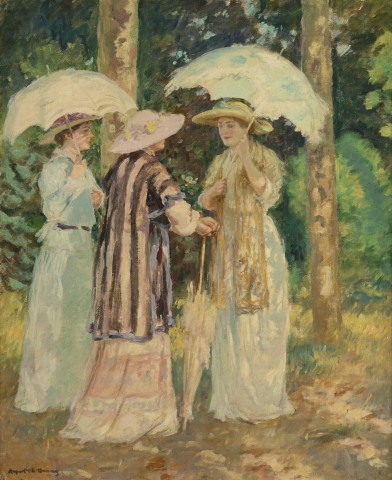RENCONTRE DANS LE PARC OR DANS L’ALLÉE, c.1912 – 13
RUPERT BUNNY
oil on canvas
73.0 x 60.0 cm
signed lower left: Rupert C W Bunny
inscribed with title on stretcher bar verso: Dans l’Allée
inscribed on label attached verso: 12 RENCONTRE / DANS LE PARC.
Mr F E Trigg, Sydney, acquired c.1950s
Thence by descent
Private collection, Sydney
possibly: Exposition Rupert C. W. Bunny, Galerie Georges Petit, Paris, 16 –31 March 1917, cat.15 (as ‘Dans l’Allée’)
possibly: Exhibition of Paintings by Rupert C. W. Bunny, Fine Art Society’s Gallery, Melbourne, 15 - 27 November 1922, cat. 39 (as ‘Dans l’Ailée [sic.])
possibly: An Exhibition of Oil Paintings and Drawings by Rupert C. W. Bunny, Anthony Hordern and Sons Ltd Galleries, Sydney, 2 – 31 May 1923, cat. 39 (as ‘Dans l’Ailée’ [sic.])
One of the most internationally successful Australian artists of his generation, Rupert Bunny was born in Melbourne and first trained at the National Gallery School, before settling permanently in Paris during the early 1890s where la belle époque was at its height. By 1904, he had become the first Australian artist to receive an honorable mention in the Société des Artistes Francais; was elected a sociétaire of various French exhibiting institutions; and enjoyed the prestige of being the only Antipodean artist until then to have his work acquired by the French State, with Après le bain, c.1904 bought from the New Salon for the Musée de Luxembourg (now the Musée d’Orsay).
While Bunny continued to evoke an opulent, often indolent elegance in his works produced around the fin-de-siècle and early twentieth century, by the first years of World War I his paintings were ‘…evolving slowly towards a modern notion of a busy woman’s life, as she sewed, worked in the garden or chatted to a friend.’1 As Mary Eagle elucidates, ‘Bunny modified his imagery just sufficiently to hint at the change. His women were still softly pretty… but their clothes were less hampering and their expressions slightly more alert.’2 Featuring the artist’s wife, the ravishing Jeanne Heloise Morel (on the left), chatting with two female companions in the sunshine on their promenade through one of the city’s newly-renovated public parks, Rencontre dans le Parc (Dans l’Allée) captures brilliantly the spirit and élan of Parisian society during these wartime years – and the subtle shift in Bunny’s art accordingly. Like the closely related Two Ladies in a Garden, c.1913-16 (which depicts Madame Bunny seated and similarly dressed in a loose ‘tea gown’ and shading herself with a lace parasol while conversing with the same female companion as that depicted centre here wearing a very informal kimono gown),3 the present work betrays a noticeable absence of artifice, imbued rather with the artist’s genuine love of his subject and indeed, of the art of making pictures itself. With its emphasis on Parisian outdoor leisure (‘la chasse au bonheur’) and its softly Impressionistic rendering of fleeting light and lyrical colour, Rencontre dans le Parc (Dans l’Allée) attests, moreover, to the way in which Bunny created an art appropriate to his time and the conditions of modernity – assimilating avant-garde modes into establishment practice.
Transforming the prosaic into the poetic through his mastery of figure composition and feminine charm, and his exquisitely light and airy palette, thus Bunny offered contemporary audiences a vision of the everyday exuding joie de vivre and ‘…a peaceful remoteness from the ‘sturm and drang’ of modern life’.4 As leading French art critic of the day Gustave Geffroy observed of the artist’s celebrated solo exhibition at Galerie George Petit, Paris in March 1917 (in which Rencontre dans le Parc (Dans l’Allée) and the following lot 40 were possibly included), Bunny’s paintings express ‘the luminous joy of daylight… and the pleasure of living in the shadow of trees looking out on a festival of sunshine… [He] is a realist and a visionary, an observer of truth and a poet of the world of dreams.’5
1. Eagle, M. and Jones, J., A Story of Australian Painting, Macmillan Australia, Sydney, 1994, p. 132
2. ibid.
3. The author is most grateful to Dr David Thomas for highlighting this comparable work
4. Sydney Morning Herald, 22 September 1911, p. 7
5. Geffroy, G., ‘Rupert Bunny: Introduction’, Exposition Rupert C.W. Bunny, Galeries Georges Petit, Paris, 1917, n.p.
VERONICA ANGELATOS
